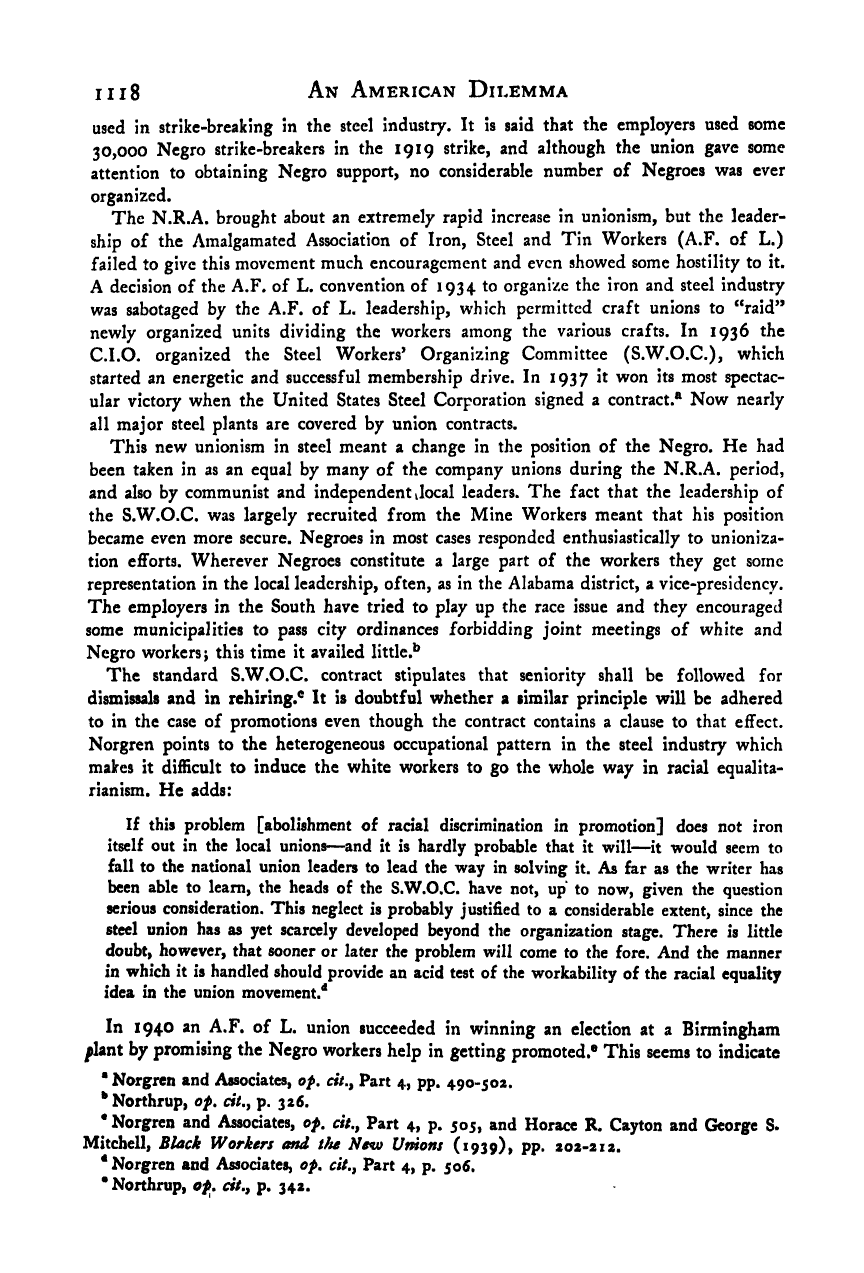Note: Gunnar Myrdal died in 1987, less than 70 years ago. Therefore, this work is protected by copyright, restricting your legal rights to reproduce it. However, you are welcome to view it on screen, as you do now. Read more about copyright.
Full resolution (TIFF) - On this page / på denna sida - Appendices - 6. Pre-War Conditions of the Negro Wage Earner in Selected Industries and Occupations - 13. Iron and Steel Workers

<< prev. page << föreg. sida << >> nästa sida >> next page >>
Below is the raw OCR text
from the above scanned image.
Do you see an error? Proofread the page now!
Här nedan syns maskintolkade texten från faksimilbilden ovan.
Ser du något fel? Korrekturläs sidan nu!
This page has never been proofread. / Denna sida har aldrig korrekturlästs.
iii8 An American Dilemma
used in strike-breaking in the steel Industry. It is said that the employers used some
30,000 Negro strike-breakers in the 1919 strike, and although the union gave some
attention to obtaining Negro support, no considerable number of Negroes was ever
organized.
The N.R.A. brought about an extremely rapid increase in unionism, but the leader-
ship of the Amalgamated Association of Iron, Steel and Tin Workers (A.F. of L.)
failed to give this movement much encouragement and even showed some hostility to it.
A decision of the A.F. of L. convention of 1934 to organize the iron and steel industry
was sabotaged by the A.F. of L. leadership, which permitted craft unions to “raid”
newly organized units dividing the workers among the various crafts. In 1936 the
C.I.O. organized the Steel Workers’ Organizing Committee (S.W.O.C.), which
started an energetic and successful membership drive. In 1937 it won its most spectac-
ular victory when the United States Steel Corporation signed a contract.* Now nearly
all major steel plants are covered by union contracts.
This new unionism in steel meant a change in the position of the Negro. He had
been taken in as an equal by many of the company unions during the N.R.A. period,
and also by communist and independent vlocal leaders. The fact that the leadership of
the S.W.O.C. was largely recruited from the Mine Workers meant that his position
became even more secure. Negroes in most cases responded enthusiastically to unioniza-
tion efforts. Wherever Negroes constitute a large part of the workers they get some
representation in the local leadership, often, as in the Alabama district, a vice-presidency.
The employers in the South have tried to play up the race issue and they encouraged
some municipalities to pass city ordinances forbidding joint meetings of white and
Negro workers; this time it availed little.**
The standard S.W.O.C. contract stipulates that seniority shall be followed for
dismissals and in rehiring.^ It is doubtful whether a similar principle will be adhered
to in the case of promotions even though the contract contains a clause to that effect.
Norgren points to the heterogeneous occupational pattern in the steel industry which
makes it difficult to induce the white workers to go the whole way in racial equalita-
rianism. He adds:
If this problem [abolishment of racial discrimination in promotion] does not iron
itself out in the local unions—and it is hardly probable that it will—it would seem to
fall to the national union leaders to lead the way in solving it. As far as the writer has
been able to learn, the heads of the S.W.O.C. have not, up to now, given the question
serious consideration. This neglect is probably justified to a considerable extent, since the
steel union has as yet scarcely developed beyond the organization stage. There is little
doubt, however, that sooner or later the problem will come to the fore. And the manner
in which it is handled should provide an acid test of the workability of the racial equality
idea in the union movement.^
In 1940 an A.F, of L. union succeeded in winning an election at a Birmingham
^lant by promising the Negro workers help in getting promoted,® This seems to indicate
• Norgren and Associates, op, cit.^ Part 4, pp, 490-502.
^Northrop, of, cit,y p. 326.
• Norgren and Associates, of. cit,, Part 4, p, 505, and Horace R. Cayton and George S.
Mitchell, Black Workers and the New Unions (1939), pp. 202-212,
•
Norgren and Assodates, of, cit,, Part 4, p. 506,
• Northrop, op, cit,, p, 342,
<< prev. page << föreg. sida << >> nästa sida >> next page >>